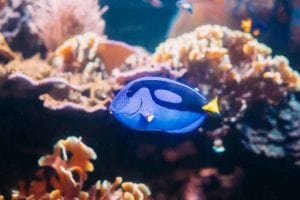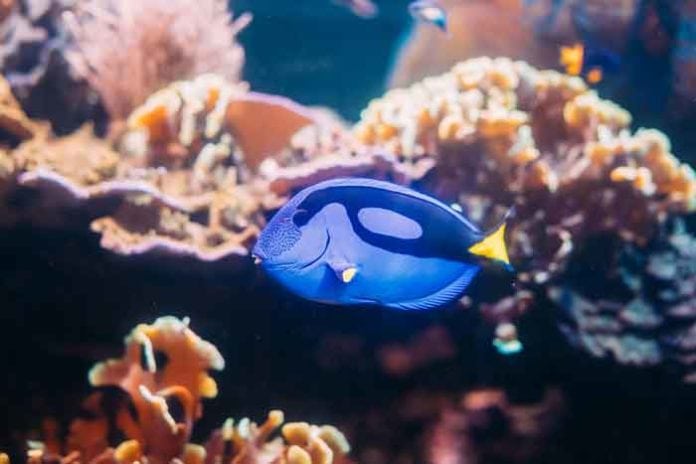Care Requirements for the Blue Hippo Tang (Paracanthurus hepatus)
- Care Level: Moderate
- Temperament: Semi-aggressive
- Color Form: Blue
- Diet: Herbivore
- Reef Compatible: Yes
- Water Conditions: 72-78° F, dKH 8-12, pH 8.1-8.4, sg 1.020-1.025
- Max. Size: 1′
- Origin: Fiji, Indonesia, Maldives
- Family: Acanthuridae
- Minimum Tank Size: 180 gallons

Acclimating Blue Hippo Tangs
Blue hippo tangs, as with all fish, should be placed in quarantine for a few days or up to a week prior to introducing to your tank. Especially when introducing them to a tank with a delicate and diverse eco-system. The blue hippo tang is more susceptible to protozoan diseases, marine ich, and velvet that can be harmful to inverts and coral. Water filtration is an important factor here. Make sure pumps and filters are cleaned regularly, every couple weeks, and that at least 20% of the tank water is replaced on a weekly basis.
A 90-gallon tank is about the smallest you want to go here, and if planning on having two or more tangs, a larger tank is necessary. With multiple tangs, introduce both at the same time and ensure that there is plenty of room to swim. This is an energetic species and they need to move about to keep them happy and reduce aggression.
Diet & Feeding Requirements for Blue Hippo Tangs
Their diet is mostly that of an herbivore, although it can be supplemented with meaty proteins at times. They should be fed 2-3 times a day with plenty of live rock in the tank to allow for additional grazing. Good grazing options included dried algae flakes, seaweed, spirulina, and other nutritional supplements. This is important for boosting the immune system to ward off disease and parasites.
Blue hippo tangs also promote coral health. Their diet of algae will keep them picking at any excess growth on the coral that may block oxygen and nutrients.
Fun Facts of Blue Hippo Tangs:
Playing Dead
When stress and trying to evade a predator, the Blue Hippo Tang will often play dead. Its narrow body will simply go limp as it lies completely horizontally, laying motionless for long moments at a time. It’s an interesting site to be seen, but don’t let it fool you.
Sharp Caudal Spine
Playing dead is not their only form of defense. When extended, the sharp caudal spines located on their scales can cut deep. This has earned it the nickname, surgeonfish. If in a defensive posture, the fish will thrash about using its spine to cut any potential predators.
Color Changing
The fish will change color during spawning. It can go from a bright blue to a pale bluish tint during this time.

















